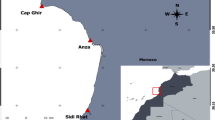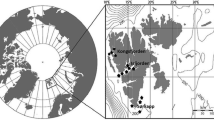Abstract
Little information exists on the gonadal development and maturity scale of Octopus ocellatus, an economically important octopus species commonly found in the west Pacific Ocean. A total of 171 O. ocellatus samples were collected monthly off the coast of northeast China (Qingdao, Shandong) from December 2011 to November 2012. Total body weight, mantle length, gonadosomatic index, and reproductive tract parameters of the samples were analyzed in males and females. The process of gonadal development in O. ocellatus was defined based on gonadal histological examination. Nine stages of oocyte development were identified during oogenesis, and a maturity scale of five stages (immature, developing, maturing, mature, and spent) was proposed for both ovary and testis. Additionally, the maturation status and dominant germ cell types of O. ocellatus in relation to monthly variation were identified. The seasonal changes showed that O. ocellatus off the coast of Qingdao is a fast-growing species with a short life span, which reproduces only once in a lifetime and then dies. Its reproductive cycle can be divided into four periods, beginning with the breeding period from April. Males become sexually mature in a smaller size than females, indicating that the mating behavior occurs early with sperm stored in the oviductal glands of the females before fertilization and spawning. This work contributes to the understanding of the maturation process in O. ocellatus, laying a foundation for further study on the mechanism of sperm storage in female octopuses and providing a reference for artificial breeding and fisheries impact assessment of this species.













Similar content being viewed by others
References
Lu C, Zheng X, Lin X (2012) Diversity of Cephalopoda from the waters of the Chinese mainland and Taiwan. In: Proceeding of the 1st Mainland and Taiwan symposium on marine biodiversity studies, pp 76–87 (in Chinese)
Dong Z (1988) Fauna sinica: Phylum mollusca. Class cephalopoda. Science Press, Beijing (in Chinese)
Yang J, Wang W, Zheng X, Zhou Q, Zhang Y, Sun G, Liu X (2011) The ultrastructure of the spermatozoon of Octopus ocellatus Gray, 1849 (Cephalopoda: Octopoda). Chin J Oceanol Limnol 29:199–205
Yamamoto T (1941) The breeding habits of Octopus ocellatus Gray, with observations on its hatched young. Plants Anim 9:9–14 (in Japanese)
Yamamoto T (1941) Some observations on the embryonal development of the eggs of Octopus ocellatus Gray. Plants Anim 9:31–35 (in Japanese)
Zhang X (2002) The breeding action and embryogensis of Octopus ocellatus in the man-made environment. J Zhejiang Ocean Univ (Nat Sci) 21:220–224 (in Chinese)
Wang W, Yang J, Zhou Q, Zheng X, Zhang Y, Sun G, Liu X (2010) Reproductive behaviour and process of embryonic development of Octopus ocellatus. J Fish Sci China 17:1157–1165 (in Chinese)
Yamauchi K, Takeda F (1964) Laboratory experiment on hatching of Octopus ocellatus. Aquaculture 12:1–9 (in Japanese)
Kitajima C, Hayashida G (1985) On the laboratory culture of Octopus ocellatus. Aquaculture 32 (in Japanese)
Segawa S, Nomoto A (2002) Laboratory growth, feeding, oxygen consumption and ammonia excretion of Octopus ocellatus. Bull Mar Sci 71:801–813
Wang W, Yang J, Zhou Q, Zhang Y, Sun G, Liu X (2009) Observation on the cannibalistic behaviour among Octopus ocellatus larvae. J Aquac 30:14–18 (in Chinese)
Ebisawa S, Tsuchiya K, Segawa S (2011) Feeding behavior and oxygen consumption of Octopus ocellatus preying on the short-neck clam Ruditapes philippinarum. J Exp Mar Biol Ecol 403:1–8
Boyle PR, Rodhouse PG (2005) Cephalopods: ecology and fisheries. Blackwell Science, Oxford
Oosthuizen A, Smale MJ (2003) Population biology of Octopus vulgaris on the temperate south-eastern coast of South Africa. J Mar Biol Assoc UK 83:535–541
Rodríguez-Rúa A, Pozuelo I, Prado MA, Gómez MJ, Bruzón MA (2005) The gametogenic cycle of Octopus vulgaris (Mollusca: Cephalopoda) as observed on the Atlantic coast of Andalusia (south of Spain). Mar Biol 147:927–933
Idrissi FH, Koueta N, Idhalla M, Belghyti D, Bencherifi S (2006) The modalities of the sexual cycle of Octopus vulgaris in the southern Moroccan Atlantic (Tantan, Boujdour). Comptes Rndus Biol 329:902–911
Otero J, Gonzalez AF, Sieiro MP, Guerra AN (2007) Reproductive cycle and energy allocation of Octopus vulgaris in Galician waters, NE Atlantic. Fish Res 85:122–129
Silva L, Ramos F, Sobrino I (2004) Reproductive biology of Eledone moschata (Cephalopoda: Octopodidae) in the Gulf of Cádiz (south-western Spain, ICES Division IXa). J Mar Biol Assoc UK 84:1221–1226
Krstulović Šifner S, Vrgoć N (2009) Reproductive cycle and sexual maturation of the musky octopus Eledone moschata (Cephalopoda: Octopodidae) in the northern and central Adriatic Sea. Sci Mar 73:439–447
Pliego-Cárdenas R (2009) Biología reproductiva del pulpo octopus hubbosorum Berry, 1953 (cephalopoda, octopodidae) en la Isla Espíritu Santo. Instituto Politécnico Nacional. Centro Interdisciplinario de Ciencias Marinas, Golfo de California (in Spanish)
ICES (2010) Report of the Workshop on sexual maturity staging of Cephalopods. ICES, Livorno, p 97
Juanico M (1983) Squid maturity scales for population analysis. Adv Assess World Cephalop Resour 341–378
Arkhipkin AI (1992) Reproductive system structure, development and function in cephalopods with a new general scale for maturity stages. J Northwest Atl Fish Sci 12:63–74
Sauer WH, Lipinski MR (1990) Histological validation of morphological stages of sexual maturity in chokka squid Loligo vulgaris reynaudii D’Orb (Cephalopoda: Loliginidae). S Afr J Mar Sci 9:189–200
Goncalves I, Sendão J, Borges TC (2002) Octopus vulgaris (Cephalopoda: Octopodidae) gametogenesis: a histological approach to the verification of the macroscopic maturity scales. Abhandlungen der Geologischen Bundesanstalt 57:79–88
Khallahi O (2001) Étude de la gametogenese chez le poulpe Octopus vulgaris (Cuvier, 1797). Bull Scientifique du Cent Nati de Rech Océanographiques et des Pêches 28:44–52 (in French)
Peterson RP (1959) The anatomy and histology of the reproductive systems of Octopus bimaculoides. J Morphol 104:61–87
López-Peraza DJ (2009) Descripción histológica de los estadios de madurez gonadal en los pulpos Octupus bimaculoides y Octupus rubescens. Master thesis, Ensenada (in Spanish)
Li L (2010) Studies on histology of reproductive system and cell biology on spermatogenesis and oogenesis of Octopus variabilis. Master thesis, Ningbo University, Ningbo, China (in Chinese)
Moriyasu M (1988) Analyse de la maturation sexuelle d’Eledone cirrosa (Cephalopoda: Octopoda) du golfe du Lion. Aquat Living Resour 1:59 (in French)
Ezzeddine-Najai S (1997) Maturation sexuelle d’Eledone moschata (Cephalopoda: Octopoda) du golfe de Gabès (Tunisie, Méditerranée orientale). Vie et milieu 47:69–76
Froesch D, Marthy HJ (1975) The structure and function of the oviducal gland in octopods (Cephalopoda). Proc R Soc Lond B Biol Sci 188:95–101
Relini G, Carpentieri P, Murenu M (2008) Medits Instruction Manual Version 5 rev. Biol Mar Mediterr 15:1–78
Cuccu D, Mereu M, Porcu C, Follesa MC, Cau AL, Cau A (2013) Development of sexual organs and fecundity in Octopus vulgaris Cuvier, 1797 from the Sardinian waters Mediterranean Sea. Mediterr Mar Sci 14:270–277
Boyle PR, Knobloch D (1983) The female reproductive cycle of the octopus, Eledone cirrhosa. J Mar Biol Assoc 63:71–83
Ángel G, María PS, Álvaro R, Julio MP, José LR (2013) On gonadic maturation and reproductive strategy in deep-sea benthic octopus Graneledone macrotyla. Helgol Mar Res 67:545–554
Boyle PR, Chevis D (1992) Egg development in the octopus Eledone cirrhosa. J Zool 227:623–638
Wells MJ, Wells J (1959) Hormonal control of sexual maturity in Octopus. J Exp Biol 36:1–33
Dong Z (1991) Biology of the economic species of cephalopods in the world oceans. Shangdong science and technology press, Jinan (in Chinese)
Mangold K (1983) Octopus vulgaris. Cephalop Life Cycles 1:335–364
Fernández-Nuñez MM, Hernández-González CL, Raya CP, Balguerías E (1996) Reproductive biology of Octopus vulgaris Cuvier, 1797 from north western African coast (21 N–26 N). Shellfish Committee CM/K 15
Silva L, Sobrino I, Ramos F (2002) Reproductive biology of the common octopus, Octopus vulgaris Cuvier, 1797 (Cephalopoda: Octopodidae) in the Gulf of Cádiz (SW Spain). Bull Mar Sci 71:837–850
Huang M (2004) Studies on feeding habits and nutrient level of four cephalopod species from Taiwan Strait and its adjacent areas. J Oceanogr Taiwan Strait 23:331–340 (in Chinese)
Acknowledgments
This study was supported by the National Natural Science Foundation of China (Grant Nos. 31272643, 31302215), the Shandong Provincial Natural Science Foundation (Grant No. ZR2013CQ030, BS2014NY010), and the Yantai Science & Technology Development Program (Grant No. 2011068). The authors give great thanks to the Taishan Scholars Station of Aquatic Animal Nutrition and Feed, China.
Conflicts of interest
The authors declare that they have no conflicts of interest in the research.
Author information
Authors and Affiliations
Corresponding author
Rights and permissions
About this article
Cite this article
Wang, W., Dong, G., Yang, J. et al. The development process and seasonal changes of the gonad in Octopus ocellatus Gray off the coast of Qingdao, Northeast China. Fish Sci 81, 309–319 (2015). https://doi.org/10.1007/s12562-014-0846-3
Received:
Accepted:
Published:
Issue Date:
DOI: https://doi.org/10.1007/s12562-014-0846-3




